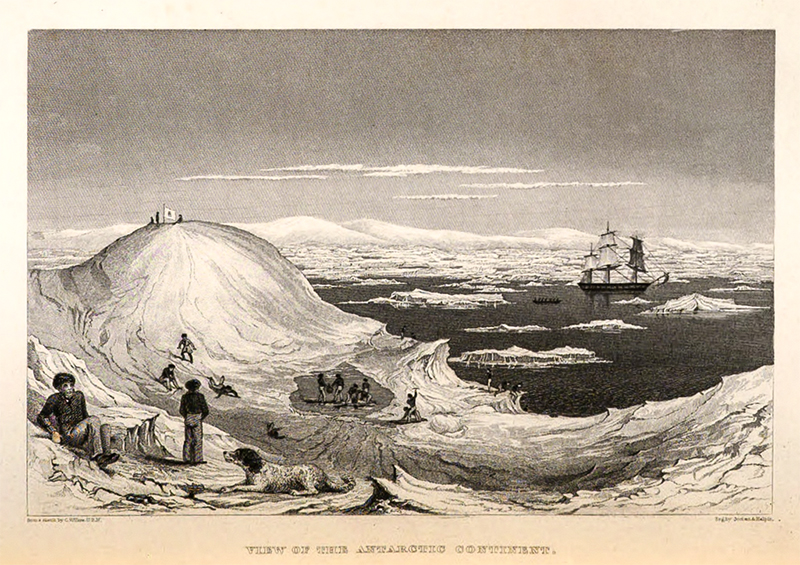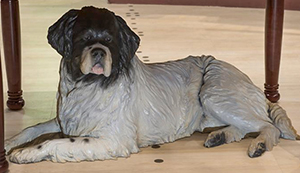[ Wilkes / The Autobiography of Rear Admiral Charles Wilkes ]
Wilkes (1798 - 1877) was a Rear Admiral in the United States Navy, and one of his signal accomplishments during his long naval career was to head the Unites States Exploring Expedition of 1838 - 1842, often referred to as the "Wilkes Expedition," which circumnavigated the globe on a scientific, cartographic, and exploratory mission that logged 87,000 miles. His survey mission also brought him into conflict with native peoples in various parts of the world, most of whom he viewed with racist disdain and sometimes treated horribly. Upon his return he was court-martialed for excessively punishing his crew, though he was acquited of most charges. He was also court-martialed later in his career, mainly for disobeying orders and insubordination due to a public feud with the Secretary of the Navy over a promotion. While he was an accomplished naval leader, his at-times arrogant and abrasive manner and often-poor treatment of his crew has led some historians to suggest he was the model for Captain Ahab in Herman Melville's Moby Dick.
Wilkes' autobiography was first published by the Naval History Division of the Department of the Navy in 1978, some 107 years after Wilkes began writing the book. In his introduction to the work, Rear Admiral John D. H. Kane, Jr., remarks that the delay may have been caused in large part by the fact that Wilke's manuscript ran to "2800 pages in horrendous handwriting." (Indeed, in the published version it is not unusual to come across "[illegible]" in the middle of a sentence.)
Wilkes is of interest here because the Exploring Expedition had, among its crew members, a Landseer Newfoundland named Sydney. Who, it is worth mentioning, is another Newf who has been honored with a statue, which resides in the Smithsonian National Air and Space Museum. Learn more about Sydney's statue at this page here at The Cultured Newf.
Wilkes' first mention of the dog (and the only time he identifies his breed) occurs more than halfway through the book, when his expedition arrives in Fiji and he invites (well, "orders" is probably more accurate) the local chief, Tanoa, to his visit him on his ship.
... he [Tanoa] got safely alongside and at length mounted the ladder and passed into the Gangway when my great Newfoundland dog Sydney recognising at once gave a growl and as Tanoa retreated towards the side he was closely followed by the dog and, as it were, pinned there . It was with some difficulty he was called off & sent away. He seemed to have a mortal antipathy [to] all this colored race. It was some time before the King recovered from his alarm and showed such evident Marks of fear that every portion of his muscular frame was in motion. He had never seen so large a dog before and spoke of the "Bullum Cow," the name given to all large animals in these islands derived from the present one Captn Eagleston had made them of a Bull and Cow and which had afterwards been adopted to designate all animals of large size. (459 - 460)
The above incident is also treated by Wilkes in his official account of the expedition, published in 1844. You can read that here at The Cultured Newf. It is also mentioned in the memoir written years later by one of the expedition's sailors, Charles Erskine, in his book Twenty Years Before the Mast, also discussed here at The Cultured Newf.
Sydney is last mentioned when Wilkes explains how the expedition members had to be particularly on their guard shortly after their capture of one of the local chieftains:
My dog Sydney was of especial service in watching over me, seemed to have the Same apprehension as entertained by the men. As he always occupied his position in my boat in the bow, he was the first on shore & if any natives were lurking about readily discovered their whereabouts and gave the alarm of their presence by a peculiar angry growl. In occupying my station for observation on the Survey, Sydney was my constant companion. After selecting the spot it [was] my custom to have the Boat' s crew to extend the Sounding lines in a circle around it without the throw of a "handy billy" which all the natives carry stuck in the girdle of their loins. The moment the line was stretched Sydney took his station within and kept moving around the circle watching the approach of all Natives to give timely warning to two of the boat's crew who were kept on guard well armed. I took my seat and went on with my observations with two revolvers by my side and, altho' I was frequently one or two hours, this faithful dog continued his rounds & watchfulness. I am satisfied these precautions and Sydney's watchfulness prevented my being attacked & I think I owe my life to him. He was the most intelligent and faithful dog I ever knew. The natives all were very much afraid of him and a word from me would have caused him to seize any one of them. He was of extraordinary size and strength and would quickly have throtled any one if instigated. To all whites he was very friendly but seemed to have imbibed a peculiar antipathy to the Blacks, or colored race. It may easily be conceived the attachment I had for him and his love for his master. Our knowledge of the Native character, a Short experience, had sufficed to know there was no trust to be put in them, and the force at my command was effective in controlling their wishes to possess themselves of our articles.
 Wilkes' own sketch of "the Antarctic continent" includes Sydney in the foreground.
Wilkes' own sketch of "the Antarctic continent" includes Sydney in the foreground.
This illustration did not appear in the Autobiography, but is from the official
Narrative of the Exploring Expedition by Wilkes

